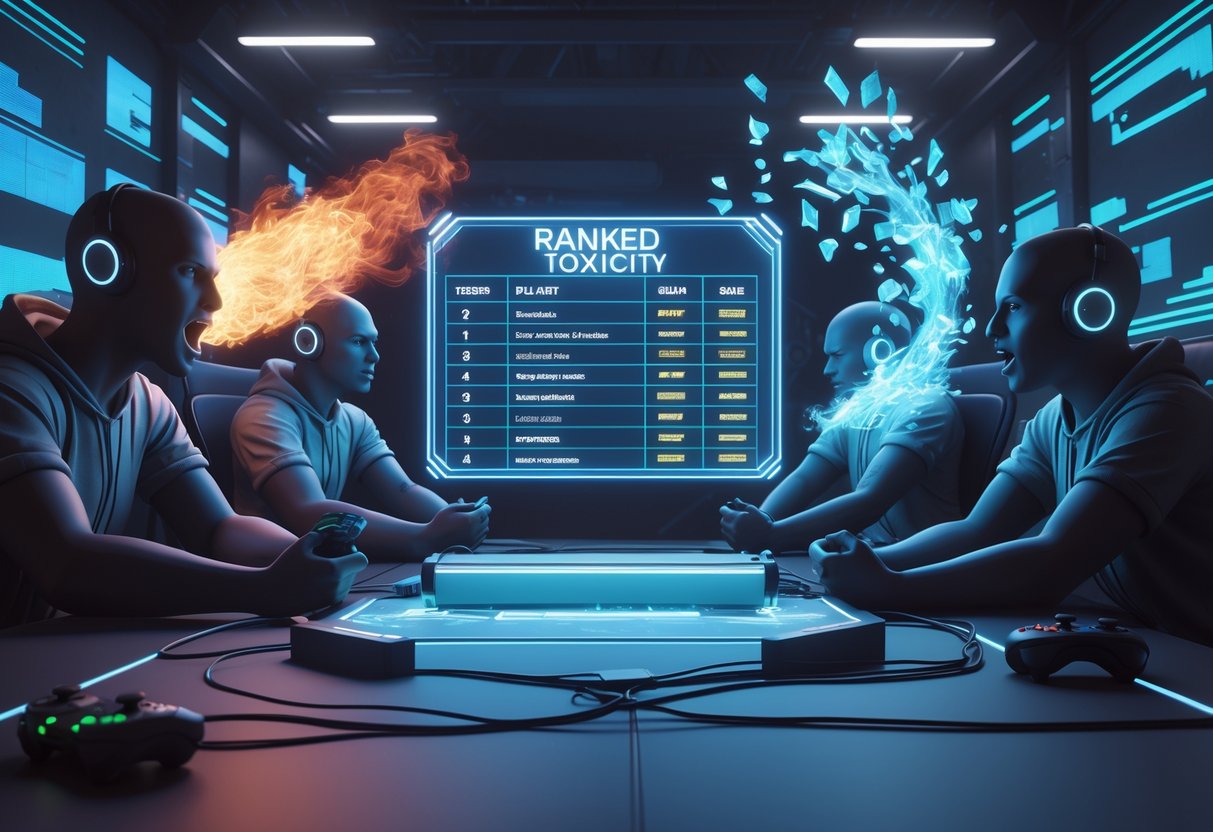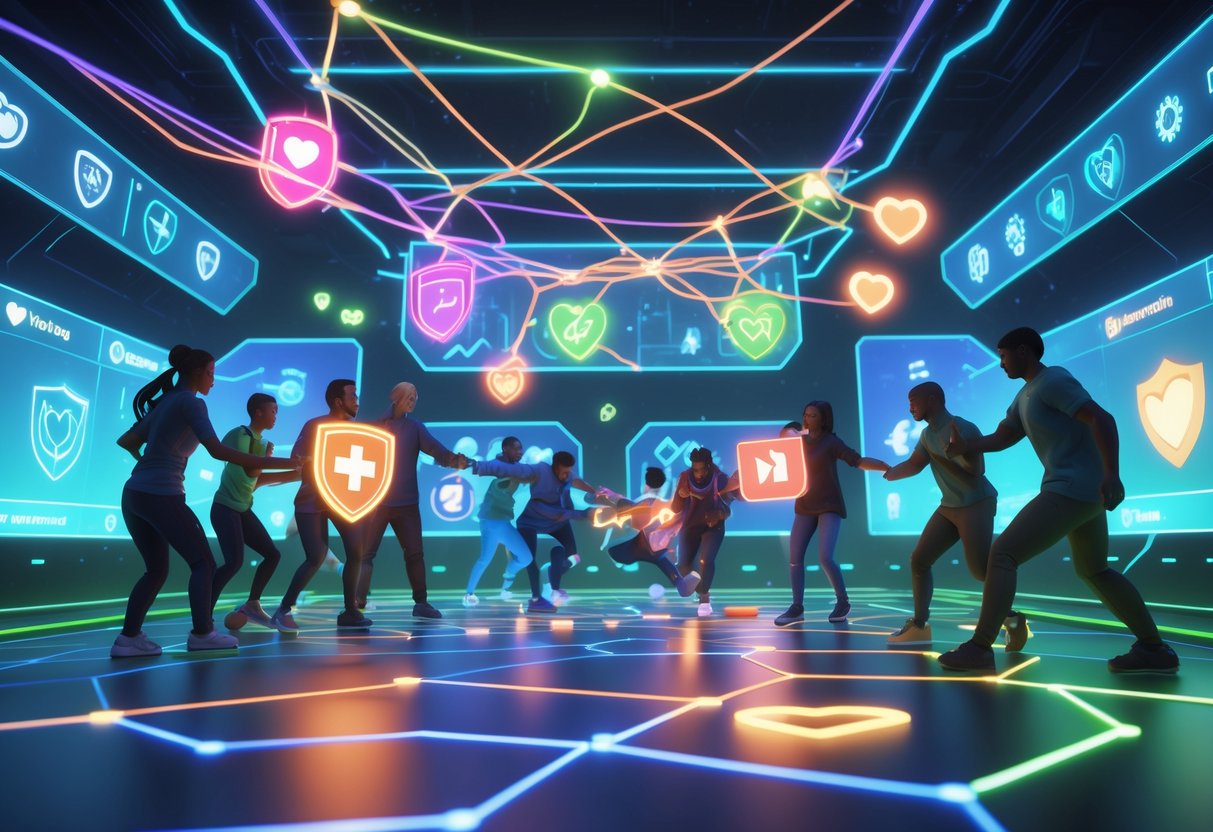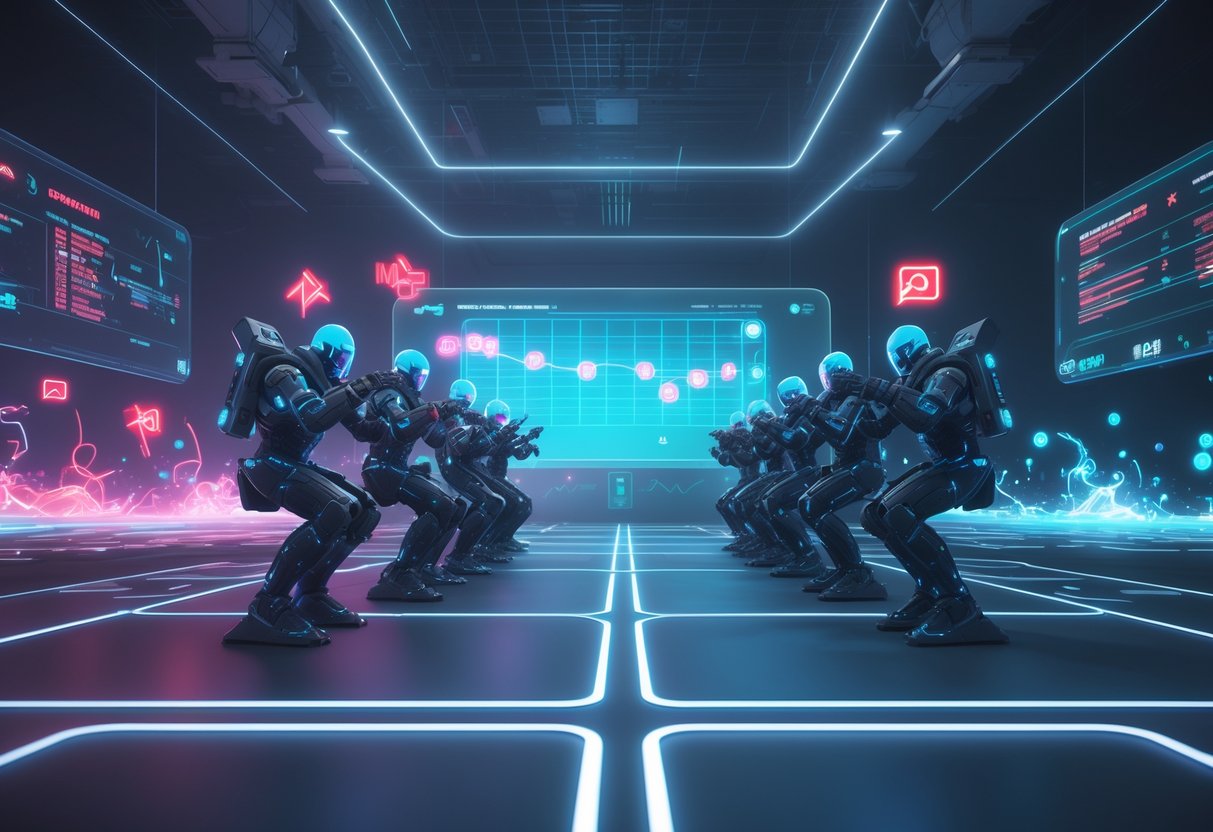Toxicity in Ranked Games: Causes, Effects, and Solutions
Updated On: November 12, 2025 by Aaron Connolly
Understanding Toxicity in Ranked Games
Toxic behavior in ranked games means players act in ways that ruin matches and make the experience miserable for others. Ranked modes crank up the pressure, so folks get more competitive—and honestly, sometimes that just brings out the worst in people.
Defining Toxic Behaviour
Toxic behavior covers actions that genuinely hurt others’ experiences during ranked matches. Verbal abuse is a big one, whether it’s in chat or over voice.
Common forms include:
- Insulting teammates for their skills or choices
- Harassing someone for personal stuff
- Griefing by feeding kills to the enemy
- Rage-quitting at crucial moments
We also spot stuff like refusing to cooperate or even sabotaging objectives on purpose. Studies have pointed out that toxic players act differently depending on their rank.
Players at higher ranks tend to use game-specific insults that only insiders really get. Meanwhile, folks in lower ranks usually stick with basic complaints or more generic insults.
Timing is a huge factor. Some toxic outbursts happen right after something frustrating. Others are more calculated—certain players pick a target and keep at it for the whole game.
Why Ranked Modes Are Prone to Toxicity
Ranked systems almost seem designed to let toxicity thrive. The competitive drive makes every mistake feel like a disaster.
Key factors include:
| Factor | Impact on Toxicity |
|---|---|
| Rank pressure | Players fear losing status or progress |
| Team dependency | Individual success relies on strangers |
| Match length | Extended frustration builds over time |
| Anonymous teammates | Reduced empathy for other players |
Players pour hours and emotional energy into their rank. Losing even one match can wipe out progress, which is just infuriating.
The expectation to give 100% every match doesn’t help. A lot of people think ranked is only for serious play, so they lash out when someone falls short.
Communication tools can be a double-edged sword. Voice chat and text are meant for teamwork, but they also make it way too easy for someone to start harassing others instantly.
Toxicity Versus General Negative Behaviour
Not every negative moment in ranked is truly toxic. It’s important to separate actual harm from normal competitive reactions.
Genuine toxicity involves:
- Personal attacks not connected to gameplay
- Purposefully sabotaging team objectives
- Ongoing harassment after the first conflict
- Trying to make others quit
Normal competitive behavior:
- Critiquing gameplay decisions
- Venting about a bad match
- Disagreeing on team strategy
- Quick emotional reactions to losing
Intent and impact make all the difference. Toxic actions aim to hurt, not help the team.
Duration and escalation matter too. A quick, angry message isn’t the same as a game-long campaign of abuse. You’ve got to look at the context before calling something toxic.
Who gets targeted also tells you a lot. Constructive criticism focuses on what someone did, not who they are. Toxic stuff gets personal—sometimes even going after things like gender or nationality.
Common Forms of Toxicity

Toxic players use a bunch of different tactics to mess with games and other players. Cheating leads at 30%, with deliberate disruption at 29%, and outright hate at 28%.
Flaming and Harassment
Flaming means insulting other players in chat or voice. Swearing, personal attacks, and aggressive language fly around—sometimes aimed at teammates, sometimes at enemies.
Harassment goes beyond just insults. Some toxic players pick on someone’s playstyle, rank, or even personal stuff they’ve mentioned.
Common flaming behaviors:
- Calling teammates “trash” after mistakes
- Using offensive language about someone’s skill
- Attacking players for their game picks
- Sending hateful DMs
Most people who play ranked say flaming shows up in almost every match. Competitive pressure seems to push some players over the edge.
Harassment doesn’t always stop when the game ends, either. Certain toxic players follow others into new matches or even onto different platforms just to keep it going.
Griefing and Throwing
Griefing means deliberately ruining the game for others. That could mean feeding the enemy, blocking teammates, or messing up objectives on purpose.
Throwing is when someone purposely loses the match. Maybe they stop trying, make dumb plays, or even help the other team.
Examples of griefing:
- Destroying team gear or resources
- Blocking doorways or escape routes
- Revealing your team’s location to enemies
- Stealing items meant for teammates
Some griefers act out because they’re mad at the team, while others just want to troll or punish someone.
Throwing usually kicks in when players think the game’s already lost. Instead of trying to come back, they just make it worse for everyone else.
AFK and Rage-Quitting
Going AFK (Away From Keyboard) means someone leaves the game running but isn’t actually playing. This forces the rest of the team to play at a disadvantage.
Rage-quitting is when someone gets mad and just leaves the match. It often happens after a string of deaths, a bad play, or a heated argument.
Both of these wreck team coordination and make winning almost impossible. The rest of the team has to scramble to fill in the gaps.
Common triggers:
- Dying a bunch in a row
- Fighting over team strategy
- Falling way behind on score or objectives
- Connection issues or lag
Some players go AFK on purpose to punish teammates, staying logged in to dodge penalties but refusing to help.
Rage-quitters often announce their exit in chat with a dramatic message before bailing out completely.
Psychological Triggers Behind Toxicity
So why do people get so toxic in ranked games? It really boils down to three big psychological factors: the crazy pressure to rank up, blaming others instead of themselves, and constantly comparing themselves to better players.
Pressure to Win
Ranked systems create this artificial sense of scarcity that triggers some pretty intense psychological reactions. When players risk losing rank, their stress responses kick in—almost like facing a real threat.
The ladder system just ramps it up. Players know a single loss can erase hours of grinding. That “loss aversion” feeling—where losing hurts more than winning feels good—really takes over.
Main pressure points:
- Limited time to hit seasonal goals
- Ranks visible to friends
- Fear of dropping down a division
- Streak-based bonuses that punish losing
Lots of players say they get physically tense during ranked games. Sweaty palms, racing heartbeats—it’s all pretty common, especially in promotion matches.
Things get especially rough during promos. If someone’s on their third try to rank up, they might start seeing teammates as obstacles instead of allies.
Self-Serving Bias
Players almost always blame losses on others but take credit for wins. This bias keeps their self-esteem safe but makes toxicity way more likely.
When things go south, our brains look for excuses that protect our self-image. Blaming teammates just feels easier than owning up to a mistake.
Examples:
- “My team fed” instead of admitting bad positioning
- “Jungler never helped” but ignoring missed opportunities
- “Support didn’t ward” while forgetting to buy wards yourself
- “Team comp sucked” after picking poorly
Stress makes this bias even stronger. Ranked anxiety pushes people to externalize blame, so their toxic comments feel justified to them.
This mindset also warps how players see others’ actions. A support taking a kill suddenly becomes “trolling” instead of just securing a point. That’s how arguments and abuse start in chat.
Impact of Social Comparison
Ranked systems force players to compare themselves to everyone else, which can make them feel inadequate or just plain angry. Seeing higher-ranked teammates can trigger defensiveness or even preemptive blame.
Ranks on display create social hierarchy pressure. Being the lowest-ranked person in a match often leads to anxiety and blame-shifting.
Triggers:
- Rank borders on loading screens
- Post-game honor systems that single people out
- Watching higher-skilled friends play
- Streamers showing off perfect mechanics
Some players develop “impostor syndrome” when they play above their usual rank. They worry about being “found out,” so they might get aggressive or start blaming others.
The comparison gets worse when someone’s stuck at a certain rank. Seeing others climb while you’re stuck can build resentment, which sometimes spills out as toxicity toward teammates.
Social media doesn’t help. Watching friends celebrate new ranks adds more pressure, turning gaming into a weird social contest instead of just fun.
Impact of Toxicity on the Ranked Experience
Toxic behavior completely changes the vibe of ranked games, and the effects stick around way longer than just one match. It messes with both immediate enjoyment and whether people even want to keep playing ranked at all.
Player Enjoyment and Retention
Toxic players suck the fun out of ranked games. New players usually get hit the hardest—they’ll often quit competitive modes after just a few bad experiences.
The fun disappears fast when teammates start flaming. Some folks even get stressed before the game starts, just expecting to be yelled at.
Over time, it adds up. Casual players stop joining ranked queues and stick to modes where things feel more chill.
Friendships can take a hit, too. Ranked performance sometimes sparks arguments between friends, and it’s not unusual for people to fall out over mistakes in competitive matches.
Retention drops hard in games with lots of toxicity. If someone keeps running into toxic players, they’ll probably take a break or just quit for good.
Match Quality and Fairness
Toxicity wrecks the competitive integrity that makes ranked games worth playing. Teams that argue usually play worse than their actual skill level.
Communication breaks down fast when flaming starts. People stop making callouts, and strategy talk goes out the window. Teams lose games they could’ve won if they just worked together.
Players sometimes give up halfway through after a toxic exchange. That leaves one team at a disadvantage for the rest of the match.
Matchmaking gets messy when players leave early or throw because of team fights. The system can’t judge real skill when toxicity ruins the game.
Smurfing becomes more common, too. Players create new accounts to dodge toxic environments, which just leads to more unfair matches for everyone else.
Detection and Enforcement Systems

Game developers rely on AI-powered tools to catch toxic behavior as it happens. They combine these with player reports and escalating penalties. The challenge? These systems have to work quickly enough to protect players mid-match, but also be accurate so they don’t punish the wrong people.
AI and Automated Chat Filters
Modern games now use machine learning to scan chat messages in real-time. These systems hunt for obvious slurs and threats, but they also try to figure out the context and intent.
Text-based detection usually catches most toxic language within seconds. The AI picks up new twists on harmful language by learning from millions of chat logs.
Advanced filters can even spot players who try to sneak past censors with creative spelling.
Voice chat is trickier. Converting speech to text eats up processing power, and players talk fast during intense ranked matches.
Some games record voice clips for human review after AI flags them.
| Detection Method | Speed | Accuracy | Coverage |
|---|---|---|---|
| Text filters | Instant | 85-90% | All chat |
| Voice analysis | 2-5 seconds | 70-80% | Limited games |
| Behaviour tracking | Post-match | 60-70% | Actions only |
Behavioural signals help catch toxicity that chat filters miss. The AI watches for patterns like intentional feeding, rage quitting, or griefing teammates.
Players who leave ranked matches a lot get flagged without anyone needing to report them.
Player Reporting and Review
Player reports still play a huge role in catching toxicity that slips past AI systems. Most competitive games let you report teammates and opponents during or after matches.
Quick reporting systems work best in ranked games. You can flag toxic behaviour with just a couple of clicks, no need to type up a long explanation.
Common categories include harassment, cheating, and unsporting conduct.
Human moderators step in for the tough cases AI can’t handle. They check chat logs, match replays, and look at multiple reports about the same player.
Usually, this review process takes 24-72 hours.
Report accuracy really matters. False reports just muddy the waters and waste moderator time.
Games track which players make accurate reports and start giving those reports more weight.
Some titles tell you when action gets taken against players you reported. That feedback encourages people to keep reporting and shows the system actually works.
Penalty Ladders and Escalation
Most competitive games don’t drop the ban hammer immediately. Instead, they use escalating punishments that get tougher with repeat offences.
Typical penalty progression:
- Warning message
- 1-3 day chat restriction
- 7-14 day ranked queue ban
- 30+ day full suspension
- Permanent account ban
Chat restrictions usually come first. Toxic players can still play ranked matches but lose access to chat and voice.
This lets them keep playing while protecting others from their outbursts.
Ranked queue bans hit competitive players where it hurts. They can only play casual modes and lose out on ranked progression for a while.
Honestly, a lot of players find this more motivating than just losing chat privileges.
Account value counts, but not always. Players with expensive skins, high ranks, or years of progress face the same rules as new accounts.
Some games do consider account history when deciding between temporary and permanent bans, but the rules stay pretty even.
Games usually reset penalty levels after 6-12 months of good behaviour. That gives reformed players a way back to normal standing without getting stuck with a permanent record.
Toxicity in League of Legends and Popular Esports Titles
League of Legends has practically become synonymous with toxic behaviour in gaming. Riot Games has suspended professional players and even banned entire teams.
The competitive nature of ranked play only makes these issues worse, so both community initiatives and developer interventions keep popping up to deal with the problem.
League of Legends: Notorious Cases
League of Legends built its reputation for toxicity through some high-profile incidents with pro players. Riot Games has suspended several big-name esports athletes for toxic behaviour in both casual and competitive matches.
Notable enforcement actions include:
- Complete team bans from Riot Games
- Professional player suspensions that blocked tournament play
- Penalties that escalate from chat restrictions to permanent account bans
The ranked system just adds fuel to the fire. Players climbing the ladder get frustrated when teammates underperform or matches spiral out of control.
Riot Games pretty much introduced “toxicity” as a buzzword in gaming. They realized early on that verbal abuse, intentional feeding, and disruptive gameplay were ruining the experience for everyone.
Community and Developer Responses
Both Riot Games and the League community have thrown a lot at the toxicity problem. Riot rolled out systems like the Tribunal (player-driven reporting), Honor System (rewarding positive behaviour), and AI-powered instant feedback.
Key anti-toxicity measures:
- LeaverBuster system: Hits players who abandon matches
- Machine learning detection: Spots abusive language in real-time
- Escalating punishments: Chat restrictions, temporary bans, permanent bans
Content creators and pro players use their platforms to promote positive behaviour. Lots of streamers call out toxic language and show good sportsmanship live.
Community-run Discord servers and forums have their own moderation. These spaces usually encourage healthier discussions about gameplay and strategy, and they don’t tolerate the negativity you see in regular matches.
Still, toxicity sticks around. The competitive environment and online anonymity make it tough to stamp out.
The pressure to win and dependence on teammates means frustration can turn toxic fast.
Honour and Reputation Systems

Game developers now reward positive behaviour with honour and reputation systems. These track sportsmanship and teamwork.
They want to reform toxic players by giving people reasons to be good and highlighting those who help their communities.
Recognising Positive Behaviour
Honour systems let players commend teammates for good behaviour, teamwork, or just being pleasant. League of Legends brought this idea in 2012, letting players vote for teammates who showed real sportsmanship.
How recognition systems work:
- Players get points for endorsements from others
- Rankings show behaviour scores next to game stats
- Rewards include exclusive skins, XP bonuses, and badges
- Top recognition like “Honour 5” gives positive players some bragging rights
Plenty of games have jumped on this. Overwatch’s endorsement system tracks leadership, teamwork, and sportsmanship separately.
Players with high endorsement levels get matched with others who behave well.
The visual part matters a lot. When teammates see those honour badges or high scores, they often step up their own behaviour.
It creates a ripple effect—good vibes spread through the match.
Influence on Player Reform
Reputation systems change toxic behaviour by making the consequences immediate and obvious. Players lose honour points after getting reported for toxicity, so there’s a direct price for acting out.
Reform mechanisms include:
- Honour loss: Bad behaviour drops your honour level
- Restricted matchmaking: Low-rep players get stuck together
- No rewards: Toxic players miss out on special loot and recognition
- Public visibility: Other players see your low honour score before matches
Research says these systems work best when combined with other tools. Players reform faster when they see both instant consequences (like losing honour) and positive examples (like high-honour teammates).
Some folks do try to game the system by acting nice only when they want endorsements. The best systems track behaviour over time, not just in single matches.
The real trick is making good behaviour actually rewarding—not just about dodging punishment. When positive players get better matches and cool rewards, toxicity just isn’t worth it.
The Role of Team Dynamics in Ranked Toxicity

Bad communication and a blame-heavy culture create the perfect storm for toxic behaviour in ranked matches. When players can’t coordinate or start pointing fingers after mistakes, matches fall apart fast.
Communication Challenges
Most ranked games force quick decisions with teammates you’ve never met. Without good communication tools or a willingness to talk, teams struggle with even basic strategies.
Voice chat is a mess in a lot of games. Some players refuse to use mics, others speak different languages, and poor audio quality can make callouts useless.
Text chat brings its own headaches:
- Typing eats up time you should be playing
- Messages get lost in the chaos
- Tone gets misread without hearing someone’s voice
You see this breakdown in games like Valorant and Apex Legends. Players make snap decisions without telling teammates what’s up.
One person rushes in while others expect to play defense.
Rank differences in the same match just add more confusion. Higher-ranked players assume everyone knows advanced strats. Lower-ranked teammates get lost and call for different plays.
The outcome? Teams that should work together end up fighting each other more than the enemy.
Blame Culture and Tilt
When things go wrong, players usually look for someone to blame instead of fixing the problem. That blame culture can turn teammates into enemies in no time.
Performance anxiety drives a lot of this. Players care more about their personal stats than team wins. Sometimes they’d rather protect their K/D than try risky plays that could help the team.
Common patterns pop up all the time:
- Role-based blaming (supports blamed for deaths, damage dealers for low kills)
- Rank shaming in mixed-skill lobbies
- Arguments over champ picks and bans before the match even starts
Tilt spreads fast through voice and text. One frustrated player starts complaining, and suddenly others give up too.
People have reported that in Bronze, four out of six recent matches had someone throw the game after a blame spiral.
The most toxic players often tie gaming rank to self-worth. They treat lower-ranked teammates as less valuable, not just less experienced.
It’s a nasty cycle—fear of blame makes players more cautious, which leads to worse teamwork and even more things to blame each other for.
Strategies for Reducing Toxicity in Ranked Games

Game developers are rolling out automated systems and incentives to tackle toxic behaviour at its roots. At the same time, gaming communities are building their own fixes through mentorship and positive culture.
Developer Initiatives
Automated Moderation Systems are the frontline defense. These AI-powered tools catch abusive language and harmful behaviour in real-time during ranked matches.
Most now use machine learning to spot patterns beyond just keywords. They look at voice tone, typing style, and even gameplay behaviour like griefing or intentional feeding.
Behavioural Incentive Systems reward positive interactions with in-game perks. Developers offer things like:
- Honour points for being helpful
- Priority matchmaking for well-behaved players
- Exclusive rewards for staying in good standing
- Shorter queue times as a bonus
Smart Game Design tackles toxicity by changing how ranked works. Modern systems focus on collaborative goals, so individual success helps the group, not just yourself.
Some games add “forgiveness” features that reduce penalties when teammates abandon matches. Others tweak difficulty to avoid frustrating skill mismatches that often spark toxic outbursts.
Community-Led Solutions
Mentorship Programmes pair veterans with newcomers. These projects teach both game mechanics and what’s expected in terms of behaviour.
Experienced players guide new ones through their first ranked matches, stopping bad habits before they start.
Positive Gaming Spaces offer alternatives focused on respect and fair competition. Discord servers, Reddit communities, and gaming groups set clear rules and have active mods.
Player-Led Reporting Networks go beyond in-game reporting. Community moderators track repeat offenders across platforms and work with developers to keep enforcement consistent.
A lot of communities now run #EndToxicity campaigns that spotlight good behaviour. Players share stories of sportsmanship and celebrate teammates who stay cool under pressure.
Personal Coping Tactics and Best Practices

Handling toxic behavior really starts with having the right mindset and a few practical tools. We can protect our mental health and even boost our gameplay just by muting at the right moments and staying positive when things get tense.
Muting and Reporting Options
It’s smart to use muting carefully—not just shutting everyone out. Most games let us mute specific players and still talk with others.
Mute toxic voices early. If someone starts getting negative, don’t wait—just mute them right away.
Smart muting strategies:
- Mute text and voice separately, depending on what you need
- Keep lines open with teammates who stay positive
- Use temporary mutes during clutch moments to stay locked in
Always report toxic behavior after your matches. Reporting helps developers spot problem players and slowly makes the community better.
A lot of support players say muting spam requests really helps. Those constant healing demands can totally wreck your focus during big plays.
Promoting a Positive Mindset
Staying positive actually starts before you even hit “queue.” Get your head ready for tough teammates and focus on what you can control.
Pre-game preparation:
- Set realistic goals for each gaming session
- Remind yourself you can’t control teammates
- Focus on getting better, not just winning
Try to keep your communication positive, even when things go sideways. Quick callouts and encouragement can actually turn a game around.
Gaming expert James Connolly puts it well: “Maintaining composure under pressure separates good players from great ones, especially in ranked environments.”
Take breaks after frustrating matches. Playing while tilted leads to bad decisions and makes toxic encounters even worse.
Combining strategic muting with real positivity works best. This protects your mental health and keeps team comms strong.
Future Challenges and Opportunities

The gaming industry faces tough choices about fighting toxicity while keeping things competitive. Advanced detection systems and community-driven solutions might finally make ranked games healthier.
Evolving Detection Technology
Anti-toxicity tech is moving way past basic chat filters now. Machine learning tools analyze voice, gameplay, and even how teams interact to spot toxic players before they can ruin matches.
Current Detection Methods:
- Real-time voice analysis for harassment
- Recognizing patterns in behavior
- Tracking toxicity across multiple matches
- Automated temp suspensions
Distinguishing between heated banter and real harassment is still tricky. Sometimes these systems punish passionate players, but miss subtle toxicity like griefing.
Developers keep testing context-aware systems. They look at match tension, player history, and even cultural differences. Maybe these tools will finally cut down the 86% harassment rate in competitive gaming.
Quick win: Machine learning now helps report systems flag serious cases faster, so response times drop from days to just hours in a lot of games.
Shaping Healthier Ranked Communities
Community-driven fixes seem to be working better than just top-down bans. Player education programs and positive rewards often change behavior more than punishments ever could.
Emerging Community Solutions:
- Veteran players mentoring newcomers
- Rewards for good behavior (like rare skins or better matchmaking)
- Team captains who can moderate
- Post-match feedback tools
Research shows 60% of gamers actually want education over harsh penalties. Games testing “good behavior” lobbies see 40% less toxicity and better player retention.
Scaling these solutions for millions of matches is still a big hurdle. Warning: If moderation goes too far, it can kill the competitive vibe and drive people away.
The best ranked scenes balance competition and respect. That’s where skill development and positive community really grow.
Frequently Asked Questions

Toxicity in ranked games trips up a lot of players—reporting, managing stress, and building better teams all come up again and again. Here are some practical answers to help you out.
How can one effectively deal with verbal abuse in competitive gaming?
The mute button is your best friend for handling verbal abuse. Most games let you mute individuals or turn off all chat mid-match.
Don’t argue with toxic players. It usually makes things worse and can get you in trouble.
Take screenshots if someone uses hate speech or threatens you. You’ll want that proof if you need to report them.
Try using the game’s profanity filter. It blocks most common slurs and swears from chat.
Quick win: Set up keybinds to mute fast, so you can shut out toxic players in seconds and stay focused.
What steps should be taken to report offensive behaviour in online matches?
File a report right after your match ends using the in-game system. Most games let you pick what kind of toxic behavior happened, like griefing or hate speech.
Include the match ID for serious stuff. That helps support teams find the exact game and review it.
Report all relevant behavior. If someone was feeding and using slurs, select both when you report.
Don’t spam reports for minor stuff. Save them for truly disruptive behavior so the system stays useful.
Some platforms like Steam or consoles have extra reporting tools. Use those for really severe cases, like threats.
Are there any effective strategies to reduce the occurrence of unsporting conduct amongst teammates?
Keep your own messages positive. People usually copy the mood they see from their teammates at the start.
Give helpful callouts instead of blaming folks. Try “let’s group up” instead of “why are you alone again?”
Shout out good plays. Even a quick “nice shot” or “good try” can help team morale.
Suggest what to do next instead of picking apart mistakes. Stay future-focused.
Warning: Don’t micromanage every move or backseat game—most players hate that and it just starts fights.
Could you guide me through managing stress and frustration while playing in a competitive environment?
Take breaks between matches, especially after a loss. Even five minutes away can help reset your mental state.
Be realistic about your ranking. Most people need hundreds of games to climb a lot.
Focus on improving your own play, not just winning. Track your stats to spot progress, even if you lose.
Try breathing exercises during loading screens. Deep breaths can calm your nerves.
Limit your ranked sessions to a set number of games per day. That way, frustration doesn’t pile up.
What systems are in place to penalise and reform players exhibiting unsociable behaviour?
Most games use escalating penalties. First offenses might get chat bans, but repeat problems lead to longer or even permanent bans.
Behavior scoring systems track your actions. League of Legends uses honor levels, Overwatch uses endorsements.
Chat filters catch certain words and hand out instant penalties for slurs or hate speech.
Some games put toxic players in low-priority queues, so they wait longer or play with other penalized folks.
Quick win: Check if your game rewards positive players—keeping a good record can mean better matchmaking for you.
How does one promote a positive atmosphere whilst engaging in competitive online games?
Kick off matches with a friendly greeting. Just saying “gl hf” (good luck, have fun) can set a chill, collaborative vibe.
Try to share helpful info, but don’t demand things from others. If you spot an enemy or have a strategy idea, toss it out there in a supportive way.
When your team nails a play or grabs an objective, take a second to celebrate it. Shout out your teammates for their good moves—it really boosts the mood.
Stick to talking about what’s happening in the game right now. There’s no point in dragging up old mistakes or losses from earlier rounds.
If voice chat’s an option, use it to keep things clear and calm. Talking things out can help everyone stay on the same page and avoid those classic text arguments.

